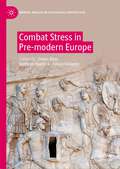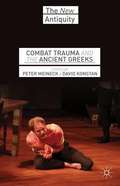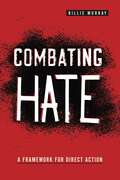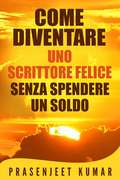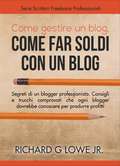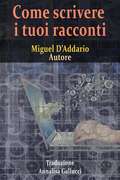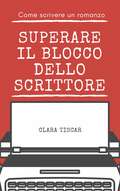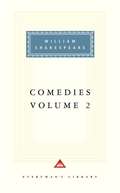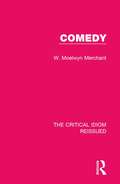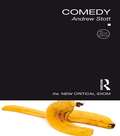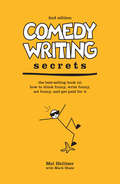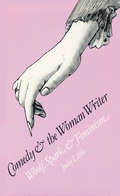- Table View
- List View
Combat Stress in Pre-modern Europe (Mental Health in Historical Perspective)
by Jason Crowley Kathryn Hurlock Owen ReesThis book examines the lasting impact of war on individuals and their communities in pre-modern Europe. Research on combat stress in the modern era regularly draws upon the past for inspiration and validation, but to date no single volume has effectively scrutinised the universal nature of combat stress and its associated modern diagnoses. Highlighting the methodological obstacles of using modern medical and psychological models to understand pre-modern experiences, this book challenges existing studies and presents innovative new directions for future research. With cutting-edge contributions from experts in history, classics and medical humanities, the collection has a broad chronological focus, covering periods from Archaic Greece (c. sixth and early fifth century BCE) to the British Civil Wars (seventeenth century CE). Topics range from the methodological, such as the dangers of retrospective diagnosis and the applicability of Moral Injury to the past, to the conventionally historical, examining how combat stress and post-traumatic stress disorder may or may not have manifested in different time periods. With chapters focusing on combatants, women, children and the collective trauma of their communities, this collection will be of great interest to those researching the history of mental health in the pre-modern period.
Combat Trauma and the Ancient Greeks
by David Konstan Peter MeineckThis ground-breaking book applies trauma studies to the drama and literature of the ancient Greeks. Diverse essays explore how the Greeks responded to war and if what we now term "combat trauma," "post-traumatic stress," or "combat stress injury" can be discerned in ancient Greek culture.
Combating Hate: A Framework for Direct Action (Rhetoric and Democratic Deliberation)
by Billie MurrayThe United States has a hate problem. In recent years, hate speech has led not only to deep division in our politics but also to violence, murder, and even insurrection. And yet established constitutional jurisprudence holds that all speech is protected as “content neutral” and that the proper democratic response to hateful expression is not regulation but “more speech.” So how can ordinary citizens stand up to hate groups when the state will not?In Combating Hate, Billie Murray proposes an answer to this question. As a participant in anti-racist and anti-fascist protests, including demonstrations against the Ku Klux Klan, neo-Nazis, and the Westboro Baptist Church, Murray witnessed firsthand the limitations of the “more speech” approach as well as the combative tactics of anti-fascist activists. She argues that this latter group, commonly known as antifa, embodies a radically different strategy for combating hate, one that explodes the myth of content neutrality and reveals hate speech to be a tactic of fascist organizing with very real, highly anti-democratic consequences. Drawing on communication theory and this on-the-ground experience, Murray presents a new strategy, which she calls “allied tactics,” rooted in the commitment to affirm, support, and even protect those who are the victims of hate speech.Engaging and sophisticated, Combating Hate contends that there are concrete ways to fight hate speech from the front lines. Murray’s urgent argument that we reconsider how to confront and fight this blight on American life is essential reading for the current era.
Combating Injustice: The Naturalism of Frank Norris, Jack London, and John Steinbeck
by Jon Falsarella DawsonIn Combating Injustice, Jon Falsarella Dawson approaches American literary naturalism as a means of social criticism, exploring the powerful economic arguments and commentaries on labor struggles presented in novels by Frank Norris, Jack London, and John Steinbeck. Making use of extensive archival research, Dawson considers many of the original periodical sources that fueled books from McTeague to The Grapes of Wrath, as Norris, London, and Steinbeck transformed contemporary materials into illustrations of the socioeconomic forces that shape American life. By depicting the operations of powerful individuals and institutions, these naturalist writers offered audiences a greater awareness of the plight of labor so that readers might find the inspiration to become agents of change. Works such as The Octopus, The Iron Heel, Martin Eden, and In Dubious Battle illuminate many of the central economic issues at play in the United States during the late nineteenth and early twentieth centuries, including the rise of commodity culture, labor disputes involving industrial and agricultural workers, widespread poverty, extreme inequality, and the concentration of resources and land ownership. Norris, London, and Steinbeck highlighted the dangers of these developments by charting their impact on central characters whose fates result from the predatory tactics of corporate monopolies, wealthy individuals, and large financial establishments. Dawson’s lucid analysis shows how all three writers, drawing on contemporary events, accentuated the need for reform and stressed the potential for change by human action. Each author took inspiration from notable events in California, ranging from the Mussel Slough tragedy of 1880 to the agricultural strikes in the Central Valley during the 1930s, presenting the state as a microcosm for conditions throughout the nation during a period of tremendous upheaval. Combating Injustice: The Naturalism of Frank Norris, Jack London, and John Steinbeck provides carefully contextualized readings of three major writers whose works express both the necessity for and the possibility of creating a more egalitarian society.
Combining Political History and Political Science: Towards a New Understanding of the Political (Routledge Approaches to History #52)
by Giorgia Priorelli Carlos Domper LasúsThis book shows how a multidisciplinary approach combining conceptual and methodological tools from political history and political science can help to develop a deeper understanding of contemporary political phenomena including democracy, populism, war, and forced migrations, among others. Throughout the eleven chapters, the volume brings together senior academics and early-career scholars to explore this innovative approach through a broad range of case studies which are not specific to any particular nation but are characteristic of contemporaneity worldwide. Both the international character and the interdisciplinary appeal of this book are reinforced by the fact that the editors and contributors come from different countries and diverse academic traditions. This book is aimed at scholars, researchers and postgraduate students interested in interdisciplinary approaches and working on politics and global phenomena in the twentieth and twenty-first centuries.
Come Autopubblicare un Romanzo con gli Amici
by Aj Tipton Benedetta AlciatoSei pronto a divertirti e guadagnare autopubblicando con gli amici? Scrivere può essere un lavoro difficile, solitario se fatto da soli. Ma non deve essere per forza così. Ti offriamo un metodo di autopubblicazione collaborativo e divertente. Se stai iniziando a conoscere il mondo dell’autopubblicazione, o hai già iniziato, questa è la guida per te! Come Autopubblicare Romanzi con gli Amici è un progetto indispensabile per trasformare le tue idee di storia in lavori pubblicati. Vogliamo salvarti dalla frustrazione e solitudine di provare a fare tutto da solo. AJ Tipton è un team di grande successo nell’autopubblicazione, ed abbiamo l’intenzione di rivelarti i nostri segreti, le lezioni guadagnate lavorando sodo, ed i trucchi che abbiamo imparato su questo eccitante mondo. Questo libro include: + Il modo migliore per scegliere il tuo coautore + Come scegliere genere e sottogenere + Un metodo a prova di errore per creare storie che vendono + Una guida interna per assumere freelance per l’editing, la creazione della copertina, le traduzioni, e molto altro + Trucchi di formattazione ed editing + Piattaforme di pubblicazione e domande da fare: Amazon, Kindle Unlimited, Nook, ecc. + I pro e i contro della traduzione del tuo libro + Come creare – ed usare – il tuo budget + Trucchi per un marketing di successo + Il potere dei social media + Come mantenere la tua collaborazione vantaggiosa, condividere il lavoro, e continuare a scrivere insieme E molto altro ancora! Se sei pronto ad essere creativo e a scrivere con gli amici, leggi questa guida punto per punto per iniziare ora il tuo viaggio verso l’autopubblicazione di successo!
Come Back for Me
by Sharon Hart-GreenLoss, trauma, memory, and, above all, the ties of family and being Jewish are the elements that weave together this panoramic story. Come Back for Me travels through time and place only to bring us, ultimately, to the connections between generations. Artur Mandelkorn is a young Hungarian Holocaust survivor whose desperate quest to find his sister takes him to post-war Israel. Intersecting Artur's tale is that of Suzy Kohn, a Toronto teenager whose seemingly tranquil life is shattered when her uncle's sudden death tears her family apart. Their stories eventually come together in Israel following the Six-Day War, where love and understanding become the threads that bind the two narratives together. Like Sarah's Key, Come Back for Me deals evocatively with the scars left by tragedy and the possibilities for healing.
Come Diventare Uno Scrittore Felice Senza Spendere Un Soldo
by Prasenjeet Kumar Dino De MaioDa Prasenjeet Kumar, l’autore di bestseller # 1 della serie “Autopubblicazione SENZA SPENDERE UN SOLDO” un vero e proprio manuale per vivere felicemente la professione di scrittore. Da come trovare la fonte d'ispirazione alla necessità di essere indulgenti con se stessi e lasciar da parte la critica a favore dei sogni, lo scrittore ci mostra come diffidare di corsi di scrittura creativa, editor e agenti letterari e dar sfogo alla propria creatività senza timori. Nella logica del SENZA SPENDERE UN SOLDO ci insegna a come farci creare una splendida copertina per il nostro libro a soli 5 dollari e ci invita a non diventare schiavi del controllo delle vendite. Passa poi a parlare della promozione che è necessaria, ma non deve diventare un'ulteriore fonte d'angoscia e di come stare alla larga dai truffatori in rete e fuori. Ci parla poi dei miracolosi risultati che si ottengono con il cosiddetto Effetto Composto ovvero di come tanti piccoli passi portino alla lunga ai risultati sperati. Alla fine della lettura avrai imparato molti segreti importanti sull'arte dello scrivere ma, soprattutto, se li metterai in pratica potrai diventare UNO SCRITTORE PIÙ FELICE!
Come Essere Femminista: Una Guida per Donne alla Lotta per Diritti e Uguaglianza
by Lauren AlexaSei mai stata vittima di violenza, odio, molestie e sofferenza dovuti al tuo sesso di appartenenza? Essere femminista e praticare gli ideali femministi significa combattere per cose importanti. Parità di salario, essere trattate con rispetto, tutela del congedo di maternità, diritti riproduttivi, violenza domestica e molto altro. Se desideri saperne di più sulla lotta per i tuoi diritti e per aiutare le donne di tutto il mondo a combattere per i propri, allora questa guida fa al caso tuo. - Impara a essere femminista. - Impara a combattere per i tuoi diritti. - Lotta per l’uguaglianza e per la parità di salario. - E Molto Altro! Scopri come fare per stare dalla parte giusta della nostra storia, aiutando l’umanità dov’è più necessario! --> Scorri verso la parte alta della pagina e clicca su “aggiungi al carrello” per effettuare immediatamente l’acquisto Disclaimer: L’autrice e/o i titolari dei diritti non avanzano pretese, promesse o garanzie relativamente all’accuratezza, alla completezza o all’adeguatezza dei contenuti di questo libro, e declinano espressamente qualsiasi responsabilità legata a eventuali errori od omissioni presenti. Il prodotto va inteso solo come riferimento. Si prega di consultare un/una professionista prima di agire sulla base dei contenuti ivi compresi.
Come diventare scrittore freelance
by Susan PalmquistChe sia per guadagnare un piccolo extra, per renderlo un lavoro full-time, per avere un trampolino di lancio prima di iniziare a scrivere libri… Hai mai pensato di diventare uno scrittore freelance? Se la risposta è sì, questo libro è fatto apposta per te. Imparerai: come creare un portfolio; come procurarti i primi agganci senza esperienza pregressa; l’importanza dello studio del tuo mercato d’interesse e il modo in cui farlo perché ti sia d’aiuto; i tipi di scrittura freelance; come raccogliere le idee; come fare il primo passo nel modo giusto; a lavorare con i redattori; cosa fare una volta ottenuto l’incarico; come trovare e intervistare gli esperti giusti per il tuo articolo; come fare per continuare a ricevere incarichi; a gestire tempo e introiti.
Come gestire un blog, Come far soldi con un blog.
by Richard G Lowe Jr Ylenia PatuzziC'è un'arte nello scrivere un articolo che ha la proprietà di invogliare il lettore ad agire. Questo è il filo conduttore del libro che state leggendo sul vostro Kindle proprio ora. Qui, imparerete come si crea un articolo che ottenga l'interesse del lettore, lo affascini, lo informi e lo spinga a prendere una decisione entro la fine della lettura. Il libro che state leggendo descrive i metodi che uso per creare articoli per blog che hanno lo specifico obiettivo di operare su una persona dal momento in cui clicca sul link fino a che preme il bottone compra o sottoscrivi sul fondo della pagina. Imparerai: * Come creare un titolo che attira il lettone nel tuo articolo * Cosa mettere "sopra la piega" * Aggiungere innesti emozionali * Connetterti coi tuoi lettori * Cos'altro aggiungere al tuo articolo * Far si che premano "Compra" * Quanto sono importanti le immagini? * E i video?
Come registrare il tuo audiolibro per Audible, iTunes, ed altre piattaforme
by George Smolinski Mattia BarattoQuesta è una guida completa con istruzioni video che vi permetterà di registrare il vostro audiolibro. Lo so perchè ho utilizzato QUESTE STESSE TECNICHE per registrare questo stesso libro per Audible! Gli audiolibri sono la più grande novità nell'ambito delle pubblizazioni oggigiorno. C'è stata una crescita esplosiva di vendite di audiolibri negli ultimi 4 anni, e voi dovete avere il vostro libro in formato audio. Questa guida vi insegnerà gli ingressi e le uscite della registrazione di audiolibri, anche se lo volete fare da soli! Argomenti discussi in questa guida: 1. L'equipaggiamento necessario per registrare audiolibri e narrazioni 2. Come iniziare a registrare audiolibri con GarageBand e Audacity 3. Consigrli e trucchi per aiutarvi partire con il piede giusto nella narrazione di audiolibri 4. Come caricare il vostro libro finito su Audible e iTunes libri 5. Risorse utili per far produrre il vostro audiolibro se non siete bravi con il fai-da-te
Come scrivere i tuoi racconti
by Miguel D'AddarioCONTENUTI - Obiettivi Narrare distinti testi letterari.Punti di vista, dialoghi, spazio, tempo. Conoscere le basi del racconto come genere letterario. Scoprire la struttura d’approccio, il nodo e la soluzione. - Metodologia Proposta d’analisi di determinati racconti. Partecipazione attiva inerente alle proposte offerte. Le proposte di lavoro vengono intese da un punto di vista descrittivo in modo da poter analizzare diversi tipi di testo. Il corso è suddiviso nelle seguenti parti: analisi del racconto, struttura, genere, spazio e tempo, personaggi, esercizi scritti per gli alunni del corso, scrittura e produzione di un testo personale. - Programma Primo avvicinamento al concetto di racconto. Lo scrittore come ricettore ed emittente. Lettura ed analisi di un racconto. L’invenzione di un mondo possibile. Elaborazione della finzione a partire da una situazione quotidiana. Proposta di scrittura. L’importanza della propria esperienza intesa come impulso per una scrittura creativa. La consistenza dei ricordi (riguardanti i vicini o i conoscenti). Proposta di scrittura. La manipolazione della realtà e della propria esperienza: elaborazione dei racconti. Proposta di scrittura. I punti di vista e la persona narrativa. Analisi dei racconti. Proposta di scrittura. Il racconto, il racconto breve. Proposta di scrittura. Linee guida per la creazione di racconti. Quadri riassuntivi.
Come scrivere un romanzo - Superare il blocco dello scrittore
by Corrado Pastore Clara TiscarVuoi scrivere ma soffri di una sorta di blocco? Provi una sensazione di panico di fronte alla pagina bianca? Se ti identifichi con le seguenti affermazioni, questo libro fa proprio al caso tuo: Voglio incominciare a scrivere ma non trovo il momento giusto Sono bloccato con il mio romanzo e non so come uscirne Ho chiara la storia che voglio raccontare ma non riesco a scriverla Non sono bloccato ma mi manca la motivazione per andare avanti a scrivere il mio romanzo Se applichi correttamente le tecniche, superare il blocco sarà molto più facile e divertente di quanto credi. Inoltre, imparerai nuovi metodi di lavoro che faranno sì che tu non ti permetteranno di non sentirti più bloccato in futuro.
Come scrivere un romanzo d'amore - Guida per principianti per scriverlo e pubblicarlo
by Susan Palmquist Maria De BonisHai mai sognato di scrivere un romanzo d’amore? In questa seconda edizione di “Come scrivere un romanzo d’amore”, imparerai suggerimenti e trucchi per cominciare a scrivere la tua storia, completarla e proporla a un editore o agente. Imparerai: -Come inventare idee per delle storie -Come pianificare il tuo romanzo -L’importanza dei primi tre capitoli -Come creare il conflitto -Come aumentare l’emozione nella storia -Come creare personaggi e dialoghi che affascinano il lettore -Come creare la tensione sessuale -Come preparare una proposta che si faccia notare -Luoghi dove proporre le tue storie -Suggerimenti di scrittura per trovare l’ispirazione Se hai mai voluto imparare il mestiere dello scrittore ma non hai mai avuto il tempo o il budget necessario per frequentare un seminario, questo libro ti offre tutto ciò di cui hai bisogno per cominciare.
Comedies
by William ShakespeareShakespeare forged his tremendous art in the crucible of his comic imagination, which throughout his life enveloped and contained his tragic one. His early comedies, with their baroque poetic exuberance, intense theatricality, explosive bursts of humor, and superbly concrete realizations of the dialects of love, capture as in a chrysalis all that he was to become. They provide a complete inventory of the mind of our greatest writer in the middle of his golden youth. This volume contains The Comedy of Errors, The Taming of the Shrew, The Two Gentlemen of Verona, Love's Labor's Lost, A Midsummer Night's Dream, and its companion piece, Romeo and Juliet, which Tony Tanner describes in his introduction as "a tragedy by less than one minute." The texts, authoritatively edited by Sylvan Barnet, are supplemented with textual notes, bibliographies, a detailed chronology of Shakespeare's life and times, and a substantial introduction in which Tanner discusses each play individually and in the context of Shakespeare's oeuvre.
Comedies, Volume 2
by William ShakespeareShakespeare's later comedies were written at the astonishing pace of about two plays a year. In them, he moves beyond the farce of his earlier comedies to richer and more varied dramas. These range from the famous "problem plays," which blend humor with tragedy, to the idyllic romances set in such timeless locales as the Forest of Arden. They contain some of his wittiest and most memorable characters, from cross-dressing heroines, bantering lovers, and wisecracking fools to the villainous but sympathetic Shylock and the boisterous and bawdy Falstaff. This volume contains The Merchant of Venice, The Merry Wives of Windsor, Much Ado About Nothing, As You Like It, Twelfth Night, All's Well That Ends Well, and Measure for Measure. The authoritatively edited text of the plays is supplemented with footnotes, bibliographies, a detailed chronology of Shakespeare's life and times, and a substantial introduction in which Tony Tanner discusses each play individually and in the context of Shakespeare's work.
Comedy (The Critical Idiom Reissued #20)
by Moelwyn MerchantFirst published in 1972, this work pursues the question ‘what is comedy?’ In its quest for an answer it explores critical theory, psychology, sociology and metaphysics. It also examines the classical origins of comedy, different kinds of comedy, the rituals of comedy, its relationship with other idioms such as ‘satire’, irony’ and ‘farce’, and compares two major traditions: ‘Aristophanic’ and ‘Shakesperean’ comedy. In doing so, the book demonstrates the indefinable and flexible nature of comedy. This work will be a valuable resource to those studying drama, and in particular, those focusing on classical and Shakespearean plays.
Comedy (The New Critical Idiom)
by Andrew StottThis new edition of Andrew Stott’s Comedy builds on themes presented in the first edition such as focusing on the significance of comic 'events' through study of various theoretical methodologies, including deconstruction, psychoanalysis and gender theory, and provides case studies of a number of themes, ranging from the drag act to the simplicity of slipping on a banana skin. This new edition features: updates to reflect new research the field new chapters on Women in Comedy and Race and Ethnicity a broader range of literary and cultural examples. Written in a clear and accessible style, this book is ideal introduction to comedy for students studying literature and culture.
Comedy Writing Secrets
by Mel Helitzer Mark ShatzThe Only Handbook for Humor Writers! "What is comedy? Comedy is the art of making people laugh without making them puke."-Steve Martin Become the funniest person in the room! With Comedy Writing Secrets, 2nd edition, you can master the fundamentals of humor writing and turn your comedic talent into a well-paying pursuit. For more than a decade, Comedy Writing Secrets has been giving aspiring comedians a leg up on the competition. In this expanded new edition, Mel Helitzer, named the "funniest professor in the country" by Rolling Stone magazine, and funnyman Mark Shatz pack in even more insight and instruction, including: Humor writing exercises to punch up your jokes. Extra information on writing for sitcoms and stand-up. Comedic brainstorming techniques using associations and listings. Exclusive tips for writing humor for specific markets like editorials, columns, speeches, advertising, greeting cards, t-shirts, and more. Tap into your comedic genius with Comedy Writing Secrets, 2nd edition, and you'll always leave 'em laughing!
Comedy Writing Secrets: The Best-Selling Guide to Writing Funny and Getting Paid for It
by Mel Helitzer Mark ShatzThe Only Handbook for Humor Writers! "What is comedy? Comedy is the art of making people laugh without making them puke."-Steve Martin Become the funniest person in the room! With Comedy Writing Secrets, 2nd edition, you can master the fundamentals of humor writing and turn your comedic talent into a well-paying pursuit. For more than a decade, Comedy Writing Secrets has been giving aspiring comedians a leg up on the competition. In this expanded new edition, Mel Helitzer, named the "funniest professor in the country" by Rolling Stone magazine, and funnyman Mark Shatz pack in even more insight and instruction, including: Humor writing exercises to punch up your jokes Extra information on writing for sitcoms and stand-up Comedic brainstorming techniques using associations and listings Exclusive tips for writing humor for specific markets like editorials, columns, speeches, advertising, greeting cards, t-shirts, and more Tap into your comedic genius with Comedy Writing Secrets, 2nd edition, and you'll always leave 'em laughing!
Comedy and Culture: Cecco Angiolieri's Poetry and Late Medieval Society (Italian Perspectives Ser. #Vol. 8)
by Fabian Alfie"This work examines the ways in which the culture and society of the Middle Ages impacted on the works of the Sienese poet, Cecco Angiolieri (c.1260-1312). It analyzes how Angiolieri's poetry conformed to medieval notions and practices of comicality. The study explores the means by which Cecco satirized important cultural movements of the late 13th and early 14th centuries, such as love literature and the ascendant Franciscan order. In addition, it looks at his relations with other writers of the day, including three insulting sonnets addressed to Dante Alighieri. The text shows that Angiolieri was not an isolated, ""bizarre"" figure, as some early 20th century scholars have described him, but rather an author in step with his times."
Comedy and the Feminine Middlebrow Novel: Elizabeth von Arnim and Elizabeth Taylor (Literary Texts and the Popular Marketplace #3)
by Erica BrownElizabeth von Arnim and Elizabeth Taylor wrote witty and entertaining novels about the domestic lives of middle-class women. Widely read and enjoyed, their work was often dismissed as middlebrow. Brown argues their skilful use of comedy and irony provided the receptive reader with subversive commentary on the cruelties and disappointments of life.
Comedy and the Woman Writer: Woolf, Spark, and Feminism
by Judy LittleRecent critics have affirmed the difficulty—perhaps the impossibility—of defining modern comedy; at the same time, some feminist scholars are seeking to understand the special comedy often present in literature written by women. Comedy and the Woman Writer responds to both these concerns of recent criticism: feminist literary theory and theories of comedy. Judy Little develops a critical apparatus for identifying feminist comedy in recent fiction, especially the radical political and psychological implications of this comedy, and then applies and tests her theory by examining the novels of Virginia Woolf and Muriel Spark. Despite recent scholarly attention to Woolf, the profound comedy of her work has been largely overlooked, and the comic fiction of Spark has seldom had the responsible and attentive criticism that it deserves. The introductory chapter draws upon anthropology and sociology, as well as literary criticism and the fiction of feminist writers such as Woolf, Doris Lessing, and Monique Wittig, to define a modern feminist comedy. Four central chapters then explore the implications of this comedy in the novels of Woolf and Spark. Little distinguishes between, on the one hand, several varieties of traditional comedy and satire and, on the other, the festive or “liminal” comedy to which feminist comedy belongs. Both Woolf and Spark mock centuries-old mythic patterns and behaviors deriving from basic social norms, as well as the values emerging from these norms. It is one thing, the author points out, to find “manners” amusing, to scourge vices, or to mock the follies of lovers; it is a much more drastic act of the imagination to mock the very norms against which comedy has traditionally judged vices, follies, and eccentricities. While the comedy of Woolf and Spark has some precedent in festive or liminal celebrations, during which even basic values and behavior are abandoned, feminist comedy displays its radical nature by implying that there is no resolution to the inverted overturned world, the world in revolutionary transition.The final chapter considers briefly, in the light of the critical model of feminist comedy, the work of several other twentieth-century writers, including Jean Rhys, Penelope Moritmer, and Margaret Drabble. The presence of radical comedy in the fiction of these and other writers suggests the need for continuing attention to the theory of feminist comedy proposed in this study.
Comedy in Literature and Popular Culture: From Aristophanes to Saturday Night Live
by James V. MorrisonComedy in Literature and Popular Culture: From Aristophanes to Saturday Night Live explores works of comedy from the past 2,500 years.James V. Morrison discusses works including those of Aristophanes and Plautus, Shakespeare and Moliere, and modern comic writers, performers, and cartoonists, such as Thomas Nast, P. G. Wodehouse, Charlie Chaplin, and Jerry Seinfeld, asking the following questions: Is comedy a mirror of our lives? Is it “funny ’cuz it’s true?” Or is it funny because it ignores reality? Should we distinguish between the plot of a comic play and the jokes found in it? Are the jokes just there to make us laugh or are the jokes as essential as the plot? Do memories of satirical portrayals on the comic stage displace recollections of the historical person? By juxtaposing works from different cultures and time periods, the book demonstrates a universal recourse to certain familiar techniques, situations, and characters.This vibrant study offers a compelling analysis of comedy as a mode, form, and genre. It is an engaging read for students and scholars of comparative literature, literary history, media studies, and theater and performance.
